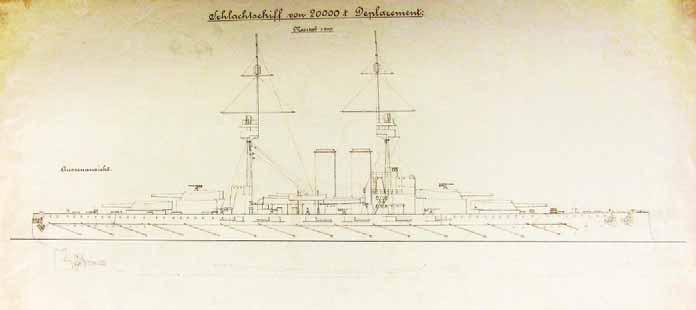clad with charges of 10 kg in 1906, but these tests provided no useful results.64 Due to this fact Popper made his own protective system based purely on theoretical calculations. The torpedo bulkhead (gepanzerte Minenboden, armored mine-bottom by the own words of Popper) of the 14,500 ton battleships was 54 mm thick, but the distance between them and the ship’s side shell plating was only 2-1.5 m which was insufficient as German test results and war experiences later demonstrated. The attempt of the Navy to save money on the tests later caused great losses. With the change of the caliber of the secondary battery from 19 to 24 cm these ships became mixed large caliber battleships. Despite being obsolete already on the drawing board, they were the first true battleships of the Austro-Hungarian Navy and they were rated powerful ships in the Adriatic and even in the Mediterranean. The French were building similar battleships (Danton class armed with 4×30.5 cm and 12×24 cm guns) and the Italians, first time in the history of the rivalry of the two navies had nothing to compare. In Italy there was a gap in the battleship construction between 1903 and 1909 and the battleships of the Regina Elena class were much inferior to the new Austro-Hungarian battleships. The fear of these battleships was the main reason for the acceleration of the Italian dreadnought program in 1908. The first Italian dreadnought (Dante Alighieri) was laid down in June 1909. The Final Design The first mixed large caliber battleships of the world were the British King Edward VII class battleships and their Japanese copies the Katori class battleships, armed with four 30.5 cm and four 23.4 cm guns. After them four “second generation” mixed large caliber battleship classes were built: the British Lord Nelson, the Japanese Satsuma, the French Danton and the Austro-Hungarian Radetzky, armed with four 30.5 cm and eight to twelve 23.4-25.4 cm guns. Due to the appearance of the all-big gun battleships all these classes were obsolete even when they entered into service. Despite its obsolescence, the Radetzky class was a giant leap for the Austro-Hungarian Navy especially in firepower. The displacement of the Ra-
detzky class battleships was 3,900 tons or 37 percent greater than the displacement of the Erzherzog Karl class battleships. The greater part of the increase of the displacement was dedicated to the armament, the thickness of the belt armor was increased only 10 percent (from 210 mm to 230 mm) while the speed of the two classes was identical. The weight of the armament of a Radetzky class battleship was 2011 tons while that of an Erzherzog Karl class battleship was 1085 tons.65 The Austro-Hungarian Navy introduced the quick-firing 30.5 cm guns on these battleships. It’s worth noting that these were the world’s first 30.5 cm guns with wedge breech and metal cartridge case in service on a battleship.66 The 30.5 cm/45 Škoda gun had an armor penetration capability almost double that of the old 24 cm/40 gun especially on greater ranges. The Austro-Hungarian gun was more potent than the 30.5 cm/40 gun of the Italian standard battleships, its projectile (450 kg) was 70 kg heavier and its armor penetration capability was 50 mm greater on every range.67 The new 24 cm/45 guns of the Radetzky class were also better and more potent than the older 40 caliber length guns. The firepower of the Radetzky class radically exceeded the firepower of the preceding classes. The four 30.5 cm guns were mounted on two twin turrets fore and aft and the eight 24 cm guns were mounted on four twin wing turrets, the six turrets were arranged in a hexagonal form. A complicated electromechanical safety system was applied to prevent hitting the other turret. This system later proved to be unreliable. The weight of a 30.5 cm twin turret was 439 tons, while a 24 cm twin turret weighed 238.8 tons. The 30.5 cm and 24 cm gun turrets were all electric operated. The anti-torpedo boat battery consisted of twenty 10 cm/50 guns. Sixteen of them were in casemates on the Batteriedeck and four in the superstructure around the funnels. The same guns constituted the main armament of the cruiser Admiral Spaun, the cruisers of the Helgoland class and the destroyers of the Tátra class. The ships had three 45 cm submerged torpedo tubes, two broadsides and one on the stem. The ships could carry twenty naval mines in a special magazine. The fire control system of the Radetzky class battleships was quite simple and similar to the prewar system of the Tegetthoff class dreadnoughts. Each of the Radetzky class battleships had two
— 38 —






























